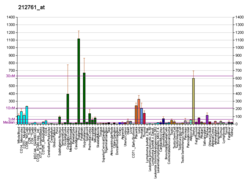Transcription factor 7-like 2 (T-cell specific, HMG-box), also known as TCF7L2 or TCF4, is a protein acting as a transcription factor that, in humans, is encoded by the TCF7L2 gene.[5][6] The TCF7L2 gene is located on chromosome 10q25.2–q25.3, contains 19 exons.[7][8] As a member of the TCF family, TCF7L2 can form a bipartite transcription factor and influence several biological pathways, including the Wnt signalling pathway.[9]
Single-nucleotide polymorphisms (SNPs) in this gene are especially known to be linked to higher risk to develop type 2 diabetes,[9] gestational diabetes,[10] multiple neurodevelopmental disorders[11][12] including schizophrenia[13][14] and autism spectrum disorder,[15][16] as well as other diseases.[17][18] The SNP rs7903146, within the TCF7L2 gene, is, to date, the most significant genetic marker associated with type 2 diabetes risk.[19]
- ^ a b c GRCh38: Ensembl release 89: ENSG00000148737 – Ensembl, May 2017
- ^ a b c GRCm38: Ensembl release 89: ENSMUSG00000024985 – Ensembl, May 2017
- ^ "Human PubMed Reference:". National Center for Biotechnology Information, U.S. National Library of Medicine.
- ^ "Mouse PubMed Reference:". National Center for Biotechnology Information, U.S. National Library of Medicine.
- ^ "Entrez Gene: TCF7L2".
- ^ Castrop J, van Norren K, Clevers H (February 1992). "A gene family of HMG-box transcription factors with homology to TCF-1". Nucleic Acids Research. 20 (3): 611. doi:10.1093/nar/20.3.611. PMC 310434. PMID 1741298.
- ^ "TCF7L2 transcription factor 7 like 2 [Homo sapiens (human)] - Gene - NCBI". www.ncbi.nlm.nih.gov. Retrieved 2017-11-30.
- ^ Online Mendelian Inheritance in Man (OMIM): TRANSCRIPTION FACTOR 7-LIKE 2;TCF7L2 - 602228{
- ^ a b Jin T, Liu L (November 2008). "The Wnt signaling pathway effector TCF7L2 and type 2 diabetes mellitus". Molecular Endocrinology. 22 (11): 2383–2392. doi:10.1210/me.2008-0135. PMID 18599616.
- ^ Cite error: The named reference
Zhang_2013was invoked but never defined (see the help page). - ^ Fitzgerald TW, Gerety SS, Jones WD, Van Kogelenberg M, King DA, McRae J, et al. (Deciphering Developmental Disorders Study) (March 2015). "Large-scale discovery of novel genetic causes of developmental disorders". Nature. 519 (7542): 223–228. Bibcode:2015Natur.519..223T. doi:10.1038/nature14135. PMC 5955210. PMID 25533962.
- ^ Clayton S, Fitzgerald TW, Kaplanis J, Prigmore E, Rajan D, Sifrim A, et al. (Deciphering Developmental Disorders Study) (February 2017). "Prevalence and architecture of de novo mutations in developmental disorders". Nature. 542 (7642): 433–438. Bibcode:2017Natur.542..433M. doi:10.1038/nature21062. PMC 6016744. PMID 28135719.
- ^ Hansen T, Ingason A, Djurovic S, Melle I, Fenger M, Gustafsson O, et al. (July 2011). "At-risk variant in TCF7L2 for type II diabetes increases risk of schizophrenia". Biological Psychiatry. 70 (1): 59–63. doi:10.1016/j.biopsych.2011.01.031. PMID 21414605. S2CID 42205809.
- ^ Liu L, Li J, Yan M, Li J, Chen J, Zhang Y, et al. (April 2017). "TCF7L2 polymorphisms and the risk of schizophrenia in the Chinese Han population". Oncotarget. 8 (17): 28614–28620. doi:10.18632/oncotarget.15603. PMC 5438676. PMID 28404897.
- ^ Wang T, Hoekzema K, Vecchio D, Wu H, Sulovari A, Coe BP, et al. (October 2020). "Large-scale targeted sequencing identifies risk genes for neurodevelopmental disorders". Nature Communications. 11 (1): 4932. Bibcode:2020NatCo..11.4932W. doi:10.1038/s41467-020-18723-y. PMC 7530681. PMID 33004838.
- ^ Satterstrom FK, Kosmicki JA, Wang J, Breen MS, De Rubeis S, An JY, et al. (February 2020). "Large-Scale Exome Sequencing Study Implicates Both Developmental and Functional Changes in the Neurobiology of Autism". Cell. 180 (3): 568–584.e23. doi:10.1016/j.cell.2019.12.036. PMC 7250485. PMID 31981491.
- ^ Torres S, García-Palmero I, Marín-Vicente C, Bartolomé RA, Calviño E, Fernández-Aceñero MJ, et al. (January 2018). "Proteomic Characterization of Transcription and Splicing Factors Associated with a Metastatic Phenotype in Colorectal Cancer". Journal of Proteome Research. 17 (1): 252–264. doi:10.1021/acs.jproteome.7b00548. hdl:10261/160082. PMID 29131639.
- ^ Cite error: The named reference
Vallée_2017was invoked but never defined (see the help page). - ^ Vaquero AR, Ferreira NE, Omae SV, Rodrigues MV, Teixeira SK, Krieger JE, et al. (October 2012). "Using gene-network landscape to dissect genotype effects of TCF7L2 genetic variant on diabetes and cardiovascular risk". Physiological Genomics. 44 (19): 903–914. doi:10.1152/physiolgenomics.00030.2012. PMID 22872755. S2CID 35065699.
- ^ PDB: 2GL7; Sampietro J, Dahlberg CL, Cho US, Hinds TR, Kimelman D, Xu W (October 2006). "Crystal structure of a beta-catenin/BCL9/Tcf4 complex". Molecular Cell. 24 (2): 293–300. doi:10.1016/j.molcel.2006.09.001. PMID 17052462.








